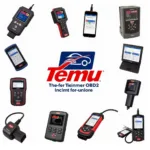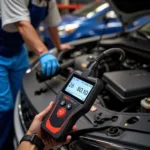OBD2 diagnostic codes are like secret messages your car sends when something’s not quite right. But can these codes really reveal everything wrong with your vehicle? Let’s dive into the world of OBD2 codes and find out.
What are OBD2 Diagnostic Trouble Codes?
Imagine your car has a built-in mechanic, constantly monitoring its systems. This mechanic communicates through OBD2 diagnostic trouble codes, alphanumeric codes that indicate a specific issue within your car’s engine, transmission, emissions system, or other components. These codes are standardized across most vehicles sold in the US after 1996.
How Do OBD2 Codes Work?
When a sensor in your car detects a problem, it sends a signal to the car’s computer, also known as the Engine Control Unit (ECU). The ECU analyzes the signal and, if necessary, generates a specific OBD2 code. This code is then stored in the ECU’s memory.
You can access these codes using an OBD2 scanner, a handheld device that connects to your car’s OBD2 port. The scanner retrieves the codes from the ECU and displays them on its screen.
Types of OBD2 Diagnostic Codes
There are thousands of OBD2 codes, each with a specific meaning. These codes are generally categorized into four types:
- Powertrain (P Codes): These codes relate to the engine, transmission, and associated components.
- Body (B Codes): These codes pertain to issues with body electronics, such as airbags, power windows, and central locking.
- Chassis (C Codes): These codes indicate problems with the chassis systems, including ABS, traction control, and suspension.
- Network & Communication (U Codes): These codes relate to problems with the communication network between different modules in the vehicle.
Can OBD2 Codes Tell You Everything?
While OBD2 codes are incredibly helpful, they don’t tell you everything wrong with your car. Here’s why:
- Codes Indicate Symptoms, Not Exact Causes: Think of OBD2 codes as symptoms of an illness. A headache could be a sign of stress, lack of sleep, or something more serious. Similarly, a code like P0420 (Catalyst System Efficiency Below Threshold) indicates a problem with the catalytic converter but doesn’t reveal the root cause – it could be a faulty oxygen sensor, engine misfire, or a failing catalytic converter itself.
- Codes Don’t Cover Everything: OBD2 primarily focuses on emissions-related systems and major components. Issues with smaller components like window motors or interior lights might not trigger an OBD2 code.
- Codes Can Be Misleading: A faulty sensor can sometimes trigger a cascade of unrelated codes. It takes expertise and further diagnosis to pinpoint the actual problem.
Beyond OBD2 Codes: The Importance of Thorough Diagnosis
OBD2 codes are a valuable starting point for car diagnostics. However, relying solely on codes can lead to misdiagnosis and unnecessary repairs.
Here’s where a comprehensive approach is crucial:
- Check Engine Light is On? Don’t Panic: A glowing check engine light doesn’t always mean a catastrophic issue. It could be something as simple as a loose gas cap.
- Use a Quality OBD2 Scanner: Invest in a reliable scanner that provides accurate code readings and additional data like freeze frame data and live sensor readings. temu obd2 scanner review
- Consult a Service Manual: Each vehicle model has its own service manual with detailed information about specific codes and diagnostic procedures.
- Seek Professional Help: If you’re unsure about interpreting codes or performing further diagnosis, consult a qualified mechanic.
FAQs About OBD2 Diagnostic Codes
Q1: How often should I check my car for OBD2 codes?
It’s a good practice to check for codes periodically, especially if you notice any changes in your car’s performance.
Q2: Can I clear OBD2 codes myself?
Yes, you can clear codes using an OBD2 scanner. However, it’s important to address the underlying issue that triggered the code in the first place.
Q3: Are there any free OBD2 scanner apps?
Yes, there are several free and paid OBD2 scanner apps available for smartphones. However, the accuracy and features may vary.
Q4: My car is older than 1996. Can I still use an OBD2 scanner?
Cars manufactured before 1996 might use an older OBD system (OBD-I) that requires a different type of scanner.
Conclusion
OBD2 diagnostic codes are powerful tools for understanding your car’s health. While they provide valuable insights into potential problems, they shouldn’t be interpreted as the final word. Thorough diagnosis involves considering various factors, including code readings, vehicle history, and physical inspection. Remember, a reliable OBD2 scanner and a knowledgeable mechanic are your allies in keeping your car running smoothly.
Need help choosing the right OBD2 scanner or understanding diagnostic codes? Contact our team at WhatsApp: +1(641)206-8880, Email: [email protected]. Our 24/7 customer support team is here to assist you!


